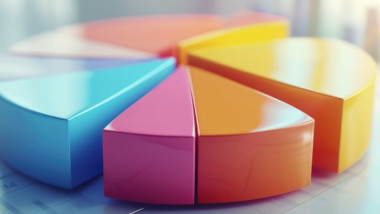Active Management in Equation: High Active Share + Long Fund Duration = Outperformance
Not all high Active Share managers are created equal. Mutual funds that frequently trade their securities systematically underperform their benchmarks, regardless of the extent to which their holdings vary from the benchmark.
Key Takeaways:
- Two criteria can be used to assess how active a portfolio is: the Active Share as a measure of the percentage of stock holdings in a manager’s portfolio that differs from the benchmark index and the fund duration, which describes how patient a manager is with their stock holdings.
- Cremers’ research shows institutions with high Active Share and long Fund Duration hold just 2.1% of all assets.
- Remaining inactive in the short term during volatile periods may result in sustainable active outperformance.
Over the past decade, academics have devoted considerable research to investment management, attempting to discern whether active management really provides value to its clients. In 2009, the concept of Active Share was developed by professors Martin Cremers and Antti Petajisto in an attempt to explain if active managers are able to beat passive alternatives.3 Within this work, the professors defined Active Share as a measure of the percentage of stock holdings in a manager’s portfolio that differ from the benchmark index. A portfolio with completely dissimilar weightings would have a measure of 100% Active Share, while a portfolio exactly replicating an index would score 0%. Found in the middle of these two extremes are the closet indexers: funds that closely emulate their benchmarks yet charge an active management fee. Anything below an Active Share score of 50% is essentially a combination of an active fund and an index fund. According to Petajisto, “Closet indexers who stay very close to the benchmark index are a particularly bad deal because they are almost guaranteed to underperform after fees given the small size of their active bets, yet they account for about one-third of all mutual fund assets.”4 These are the funds that have weighed down the average performance of global equity mutual funds.
In contrast, high Active Share strategies differ materially from their respective benchmark weights. The professors concluded that only managers with high Active Share justify their management fees. Yet as of 2012, only 10% of assets in institutional strategies received an Active Share score of greater than 80%.5
Institutions have asked us many times if this research can be applied to global equity strategies rather than being limited to long-only U.S. equity mutual funds. In fact, in 2014, Cremers confirmed that this finding can be extended globally by analyzing a large international sample of mutual funds domiciled in 32 different countries. Since the publication of this research, we find Active Share has been widely accepted as a measure to judge the amount of active management inherent in a portfolio. Consultants and institutions have utilized Active Share as a tool to justify active management fees.
While having high Active Share is a necessary pre-condition for a strategy to outperform net of fees, not all high Active Share managers outperform consistently. The industry has questioned its efficacy in being the sole predictor of future performance. Author Michael Mauboussin proposes the concept of untangling skill versus luck to identify the most successful long-term investors. Mauboussin was Chief Investment Officer at Legg Mason Capital Management during the Legg Mason Value Trust Fund’s 15-year streak of outperforming the S&P 500. He believes that Active Share, while not the end all, is a good start to finding strong active managers. Combining that with tracking error statistics and a qualitative assessment of an investor’s process – broken down into analytical, behavioral and organizational segments – are even better indicators of future successes than past performance.6
Recognizing the need to improve upon his Active Share metric, Martijn Cremers recently extended his original work in a study entitled Patient Capital Outpeformance: The Investment Skill of High Active Share Managers Who Trade Infrequently. He looked for other variables to identify which high Active Share managers outperform. Cremers introduced the metric Fund Duration, which measures the weighted-average length of time that a fund has held $1 of equities in its portfolio. This new measure looks at a strategy’s holdings over the last five years in an attempt to truly describe how patient a manager is with their stock holdings. Two additional proxies that are more readily available on databases and from the managers themselves are holdings-based fund turnover and the self-declared Fund Turnover Ratio.
Here at Harris Associates, we believe the market is efficient in the long term but can be inefficient in the near term. When volatility causes uncertainty among investors, it often triggers stock prices to move faster than business values, creating a disconnect with the intrinsic value we assign to a business. It has been our experience that it takes three to five years for this discount to value to close. Put another way, it often takes a long time to capture the entire alpha opportunity identified by our research team. By definition, we calculate the intrinsic value of a business as the expected future free cash flows discounted back to the present. We think it is especially important to focus on a company’s long-term ability to generate free cash flow – three years or more – rather than the just the next 12 months. Cremers’ study shows that the average Fund Duration across all institutions in the sample is 17 months, less than half of our time horizon. As the diagram below illustrates, the first three years of a company’s cash flow usually amount to only a small portion of its full forecasted value when using a standard cash flow valuation model.

Source: Harris Associates. Forecasted free cash flow was calculated for a typical company, defined as a company with a 20% return on equity, a discount rate of 8%, and a growing net income of 4% for 10 years and 1% into perpetuity.
Cremers’ results indicate that Active Share and Fund Duration are both important dimensions of active management that strongly interact when predicting (1) the ability of fund managers to beat their benchmarks and (2) the outperformance of the stocks held in institutional portfolios. The most active institutional managers (those with Active Shares of at least 90%) and the most patient investors (those with Fund Duration more than 24 months) outperformed their benchmarks by 2.22% per year on average. Compounding these results reveals quite a remarkable outcome. These institutional managers outperformed their benchmarks by 80% during the 27-year period (1986-2012). To us, the charts look quite similar for mutual funds, institutional strategies, as well as hedge funds, suggesting this framework for assessing investment managers can be applied in many ways.Despite the success of this approach, it is not a common practice among investors: less than 5% of institutional assets are run by the highest active share managers, and even less run their strategies in a patient and active way. Cremers’ research shows institutions with high Active Share and long Fund Duration (both top quintile) hold just 2.1% of all assets.
Patient Capital highlights the importance of distinguishing among the truly active strategies. Are the strategies pursuing short-term mispricings or do the managers patiently follow a buy and hold strategy? Cremers’ research found that the latter strategy was successful while the former was not.5
The key to sustainable active outperformance is to remain inactive in the short term. Although low turnover is not the only factor that can lead to outperformance, it is a necessary part of the investment process. When negative macro headlines about China call into question global demand for autos or micro headlines like recalls at General Motors hit, investors need to be able to withstand long periods of doubt. While some investors transform into traders of stocks at the first sign of uncertainty, a patient investor views volatility as opportunity and adheres to its disciplined, long-term approach that allows it to add value via stock selection.
No matter what investment landscape investors find themselves in, we believe an unwavering commitment to an active and patient approach is absolutely the best way for managers to protect and grow their investors’ capital over the long term.
2 Source: Strategic Insight, SimFund
3 Source: K. J. Martijn Cremers and Antti Petajisto, “How Active Is Your Fund Manager? A New Measure That Predicts Performance,” published by Oxford University Press on behalf of The Society for Financial Studies, 2009, http://www.petajisto.net/research.html.
4 Source: Antti Petajisto, “Active Share and Mutual Fund Performance,” Financial Analysts Journal, January 2013, http://www.petajisto.net/research.html.
5 Source: Martijn Cremers & Ankur Pareek “Patient Capital Outperformance: The Investment Skill of High Active Share Managers Who Trade Infrequently.” September 2014.
6 Source: Mauboussin, Michael. “The Success Equation: Untangling Skill and Luck in Business, Sports, and Investing.” Harvard Business Review Press, 2012. pg 152.
Published in February 2016
Harris Associates
Harris Associates L.P., a subsidiary of Natixis Global Asset Management, is an investment adviser registered with the U.S. Securities and Exchange Commission (IARD No. 106960) and is licensed to provide investment management services in the United States.
The company conducts all investment management services in and from the United States.
Two North LaSalle Street, Suite 500
Chicago, Illinois 60602, USA
www.harrisassoc.com
This communication is for information only and is intended for investment service providers or other Professional Clients. The analyses and opinions referenced herein represent the subjective views of the author as referenced unless stated otherwise and are subject to change. There can be no assurance that developments will transpire as may be forecasted in this material.
Copyright © 2016 NATIXIS GLOBAL ASSET MANAGEMENT S.A. – All rights reserved





 Diversification, the Blind Spot of Equity Markets
Diversification, the Blind Spot of Equity Markets
 Russia-Ukraine: The Beginning of the End?
Russia-Ukraine: The Beginning of the End?
 Loomis Sayles - Investment Outlook - April 2024
Loomis Sayles - Investment Outlook - April 2024
 Natixis IM Solutions - Market Review - March 2024
Natixis IM Solutions - Market Review - March 2024